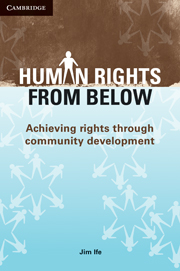Book contents
- Frontmatter
- Contents
- Acknowledgements
- Introduction
- Part 1 Thinking about community development
- 1 Definitions and imperatives of community development
- 2 Principles and dimensions of community development
- Part 2 Thinking about human rights
- Part 3 Bringing human rights and community development together
- Part 4 Enacting human rights from below
- Appendix: The human rights matrix
- References
- Index
2 - Principles and dimensions of community development
Published online by Cambridge University Press: 05 June 2012
- Frontmatter
- Contents
- Acknowledgements
- Introduction
- Part 1 Thinking about community development
- 1 Definitions and imperatives of community development
- 2 Principles and dimensions of community development
- Part 2 Thinking about human rights
- Part 3 Bringing human rights and community development together
- Part 4 Enacting human rights from below
- Appendix: The human rights matrix
- References
- Index
Summary
PRINCIPLES
As we shall see, the very nature of community development precludes specific ‘how to’ procedures for ‘doing’ community development. However, it is certainly possible to derive a number of higher-level principles which, while not being narrowly prescriptive, can nevertheless provide a framework within which community development takes place.
The perspective on community development outlined in this book is not necessarily shared by other writers. Specifically, the approaches to community development based on predetermined outcomes, top-down planning or program implementation and step-by-step processes are incompatible with the more organic and ‘from below’ perspective developed here.
Community development can be regarded as a way of thinking, as a philosophy of practice, rather than merely as a process for building stronger communities. In this sense, many people who are not specifically labelled ‘community development’ workers can still work from a community development perspective. Health professionals, teachers, development workers, social workers, lawyers, recreation workers, artists, planners, librarians and researchers are just some of the occupational groups that can, and in many cases do, work from a community development perspective by incorporating some or all of the principles discussed below into their work. Similarly, community members who may be out of the workforce for a variety of reasons (unemployed, retired, parenting or caring for a relative) or who may be employed in jobs that have nothing to do with community development, can still engage with their community according to these principles and can play key roles in community development.
- Type
- Chapter
- Information
- Human Rights from BelowAchieving Rights through Community Development, pp. 29 - 66Publisher: Cambridge University PressPrint publication year: 2009



